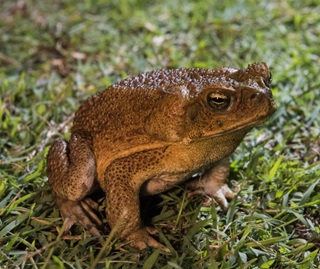What are cane toads?
 Cane toads (Rhinella marina, formerly Bufo marinus) are an invasive species. Introduced to Queensland in 1935, they are now widespread in north-eastern New South Wales and are spreading further south and west.
Cane toads (Rhinella marina, formerly Bufo marinus) are an invasive species. Introduced to Queensland in 1935, they are now widespread in north-eastern New South Wales and are spreading further south and west.
Cane toads have no natural enemies and their spread could have a devastating impact on our native animal species and ecosystems.
Why are they a pest?
Cane toads are a threat to biodiversity because they are poisonous, predatory, adaptive and competitive.
Poisonous
Cane toads are toxic at all stages of their life cycle, as eggs, tadpoles, toadlets and adults, and their ingestion can kill native predators. Cane toads have been linked to the decline and extinction of several native predator species in the Northern Territory and Queensland, including the northern quoll. Their toxin is strong enough to kill most native animals that normally eat frogs or frog eggs, including birds, other frogs, reptiles and mammals. They pose a risk to both native animals and pets.
Predatory
Cane toads eat almost anything they can swallow, including household scraps, meat and pet food. They mostly eat living insects in large quantities, including beetles, bugs, honey bees, ants, winged termites, and crickets. Cane toads will also eat larger animals, including native frogs, smaller toads, small mammals and snakes.
Adaptive
Cane toads are robust and can live in a wide variety of habitats. They thrive in urban and disturbed areas. They breed quickly, which allows them to rapidly colonise and dominate an area.
Competitive
Cane toads compete with native species for both food and habitats. They have a voracious appetite and can eat a wide variety of foods, depleting the food source for other animals. Native frogs are particularly vulnerable to the threat of cane toads both as a food source for the toad and as a competitor for other food sources.
The invasion and establishment of cane toads in New South Wales has been listed as a key threatening process in NSW by the NSW Scientific Committee.

